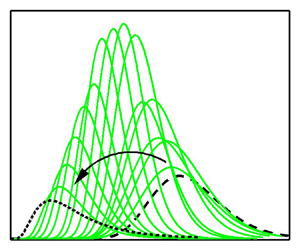Published online by Cambridge University Press: 05 October 2021

Orthogonal time-of-flight mass spectrometry has been used to characterize the kinetic energy and charged species distributions from an in vacuo electrospray ion source for four different ionic liquids at volumetric flow rates between 0.3 and 3.3 nanolitres per second. In all cases, the mass spectra revealed charged species consisting of singly charged and multiply charged ions as well as two broad, unresolved droplet distributions occurring in the 104 to 106 atomic mass unit per charge range. The mean jet velocity and mean jet breakup potential were established from analysis of the energy profile of the high mass-to-charge droplets. At the jet breakup point, we find the energy loss and the jet diameter flow rate dependence of the electrospray beam to be similar to that determined by Gamero-Castaño (Phys. Fluids, vol. 20, 2008, 032103; Phys. Rev. Fluids, vol. 8, 2021, 013701) for 1-ethyl-3-methylimidazolium bis(trifluromethylsulfonyl)imide at similar volumetric flow rates. Similar trends are observed for all four liquids over the flow regime. A jet instability analysis revealed that jet electrification and viscous effects drive the jet breakup from the case of an uncharged, inviscid jet; jet breakup occurs at droplet and jet radius ratios that deviate from 1.89. Using the analytically determined ratio and the beam profile, different species are modelled to reconstruct the mass spectra; primary droplets constitute only a fraction of the total species present. The populations of the species are discussed.
Present address: Northrop Grumman Corporation, 1575 S. Price Rd, Chandler, AZ 85286, USA.